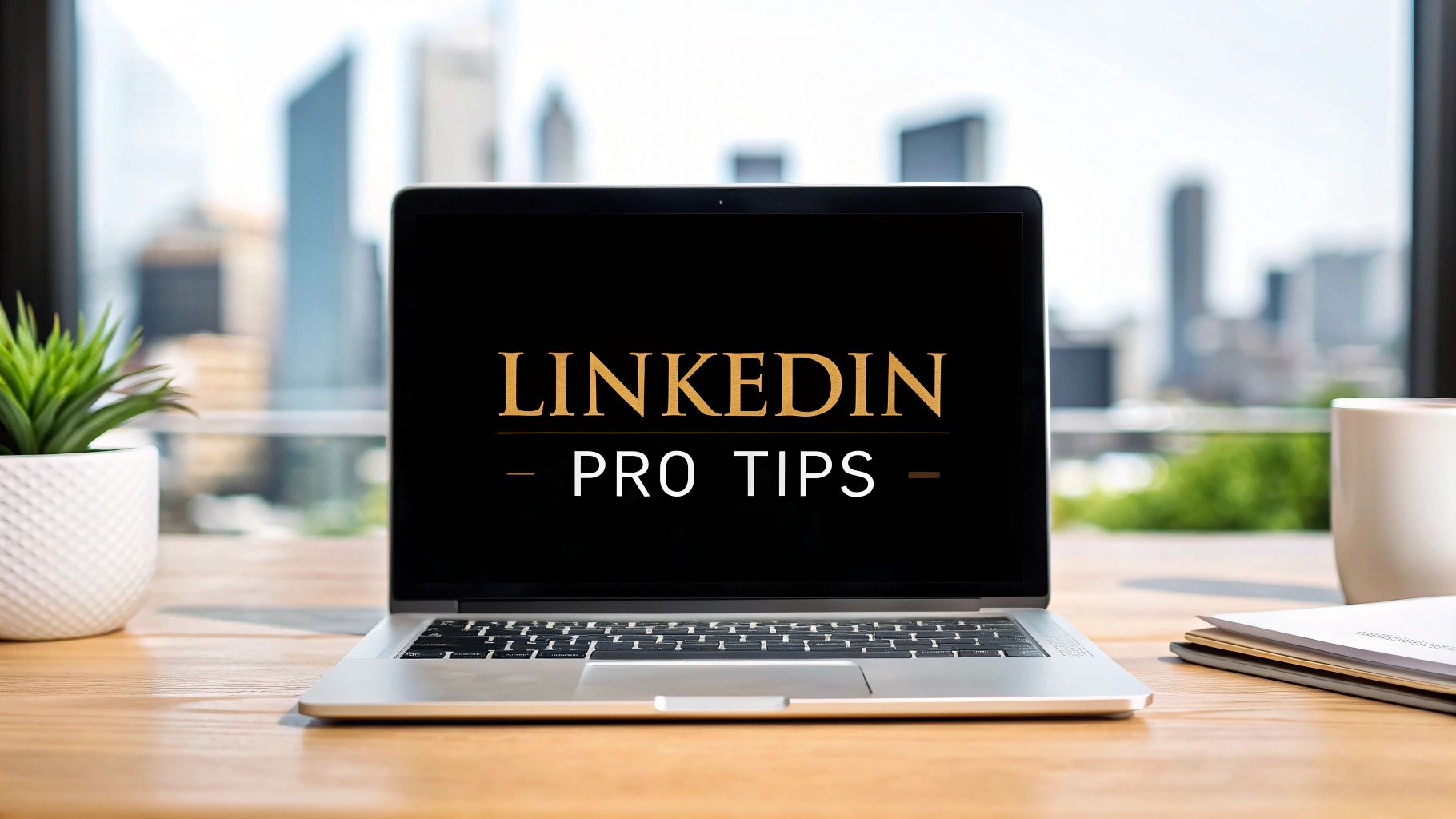
Pro Tips for Writing a LinkedIn Article
Published on 2025-04-11
Why Writing a LinkedIn Article Transforms Your Professional Brand
LinkedIn has become the central hub for professional networking. Simply having a profile isn't enough. To truly distinguish yourself and build a compelling professional brand, you need active engagement. Writing LinkedIn articles provides a powerful way to achieve this. These articles offer a platform to showcase your expertise and insights far beyond the capacity of short-form posts. This means you're not just building a presence, you're actively shaping how others perceive your professional value.
Establishing Yourself as a Thought Leader
One of the most significant advantages of writing LinkedIn articles is the potential to establish yourself as a thought leader within your industry. Sharing well-researched and insightful content positions you as a go-to source for information and valuable perspectives. This builds credibility and trust among your connections and beyond. For example, marketing professionals writing about the latest trends in digital marketing solidify their reputations as industry experts. This, in turn, can open doors to new career opportunities and potential collaborations.
Additionally, LinkedIn articles offer greater longevity than fleeting newsfeed posts. They become a permanent part of your profile, easily accessible to anyone visiting your page. This allows your content to consistently generate value and attract new connections over time. Consider your articles as evergreen content that continues working for you long after publication.
Reaching a Wider Audience and Growing Your Network
As of 2025, LinkedIn boasts over 1.2 billion members, solidifying its position as the world's largest professional networking platform. This enormous user base, combined with the platform's high engagement rate (approximately 1.77 billion monthly visits), presents a significant audience for your LinkedIn articles. Find more detailed statistics here. You have the potential to connect with a diverse group of professionals across various industries, significantly expanding your network and influence.
Furthermore, writing LinkedIn articles isn't solely about broadcasting your ideas. It's also a valuable platform for engaging in meaningful discussions with other professionals. Encouraging comments and responding thoughtfully fosters relationships and cultivates a sense of community around your area of expertise. This interaction further strengthens your brand and positions you as an accessible and engaged thought leader.
Integrating Articles Into Your Broader Visibility Strategy

While short posts are effective for quick updates and link sharing, LinkedIn articles provide the necessary space for in-depth analysis and thought leadership. Consider using a combination of both formats: short posts to pique interest and direct traffic to your longer, more comprehensive articles. This caters to different audience preferences and maximizes your overall reach.
Moreover, consistently publishing high-quality articles demonstrates a commitment to your profession and a willingness to share your knowledge. This dedication strengthens your credibility and attracts those who value expertise and continuous learning. Ultimately, this translates into a stronger professional brand and a more impactful online presence. Integrating LinkedIn articles into your broader visibility strategy is essential for long-term career growth and success in today's competitive professional landscape.
Strategic Planning Before Writing a LinkedIn Article
Creating impactful LinkedIn articles requires a strategic approach. It's not just about writing; it’s about understanding your audience and providing value within LinkedIn's professional environment. Consider your article as a targeted message, not a general broadcast. Careful planning is essential for engaging your intended readers and achieving your professional objectives.
Identifying Your Target Audience and Their Needs
Before you begin writing, determine your target audience. Are you aiming to connect with potential clients, recruiters, or colleagues in your industry? Understanding their needs, challenges, and interests is paramount. For instance, an article for entry-level professionals will differ significantly from one aimed at senior executives. This focused approach ensures relevance and genuine value.
Researching Trending Conversations and Content Gaps
Keeping up with industry trends and discussions is essential for attracting attention. Tools like LinkedIn News and following industry-specific hashtags can help identify topics resonating with your audience. Analyzing your competitors’ content can also highlight gaps and opportunities to offer unique perspectives, establishing you as a valuable voice in the conversation.
Crafting a Compelling Headline and Structure
Your headline is the first impression, often the only chance to capture a reader’s attention. It should be concise, intriguing, and clearly convey the article’s benefit. Your professional brand begins with your headline. Looking for inspiration? Check out these LinkedIn headline examples. A well-structured article with clear subheadings, bullet points, and visuals improves readability, especially on mobile devices, ensuring effective message delivery.
To help you select the right topics for your LinkedIn articles, consider using the following framework:
Introducing the "LinkedIn Article Topic Selection Framework". This table is designed to guide you in evaluating potential article topics based on key factors that contribute to engagement and professional development.
| Topic Consideration | Questions to Ask | Importance Level |
|---|---|---|
| Relevance to Audience | Does this topic align with my target audience's interests and needs? | High |
| Industry Trends | Is this topic relevant to current industry discussions and trends? | High |
| Unique Perspective | Can I offer a fresh or unique perspective on this topic? | Medium |
| Professional Value | Does this topic contribute to my professional brand and demonstrate my expertise? | High |
| Actionable Insights | Does this topic offer practical advice or takeaways for my audience? | Medium |
This framework highlights the importance of understanding your audience, aligning with industry trends, and providing valuable content that strengthens your professional brand.
Developing a Consistent Publishing Cadence
Consistency is key to audience engagement. A regular publishing schedule, whether weekly, bi-weekly, or monthly, creates anticipation. Prioritize quality over quantity. It’s better to publish fewer, high-quality articles than numerous less valuable pieces. This maintains a strong connection with your audience without compromising the depth and value of your writing.
Crafting Content That Captivates Professional Audiences

Creating compelling LinkedIn articles that truly resonate with professionals requires a deep understanding of your target audience and a strategic approach to content. It's about recognizing how professionals consume online information and tailoring your writing accordingly. This involves transforming ordinary articles into captivating pieces that command attention, build credibility, and encourage interaction.
Blending Data and Narrative
Truly effective LinkedIn articles seamlessly integrate data-driven insights with engaging narratives. Simply presenting dry statistics rarely makes an impact. Instead, weaving these statistics into a relatable story makes them more memorable and impactful.
For instance, rather than just stating market growth percentages, provide a real-world example of a company successfully capitalizing on this growth. This approach makes the data more tangible and connects with the reader's own professional experiences.
Structuring for Mobile Consumption
Given the prevalence of mobile usage on LinkedIn, optimizing your article for easy mobile reading is essential. Employ short paragraphs, clear subheadings, and bullet points to break up the text. This not only improves readability but also caters to busy professionals who often skim content while on the move.
Consider your article as a conversation. Use concise and accessible language that respects your reader’s time.
Enhancing Engagement With Visuals
Including visuals significantly enhances your message. Images, videos, and even simple infographics can effectively break up the text and illustrate complex points. Visuals also boost engagement, making your content more shareable and extending its reach.
Authenticity and personal experiences also resonate strongly with the LinkedIn audience. While maintaining professionalism, injecting your personality and unique perspective can distinguish your content. Sharing relevant anecdotes or personal experiences makes your article more relatable and memorable.
A recent study highlighted LinkedIn's significant organic reach. Just 1% of weekly posters generate a combined 9 billion impressions, demonstrating the potential for visibility even with less frequent posting. LinkedIn articles also have an average engagement rate of 2.8%, significantly higher than platforms like Facebook (0.07% organic). Images contribute significantly, driving up to 98% more comments. Explore this topic further. This underscores the importance of combining well-crafted content with compelling visuals to maximize engagement. You might also find this helpful: How to master LinkedIn posts.
Adapting Your Writing Style
Remember that the ideal writing style depends on your content type. How-to articles necessitate clear, step-by-step instructions, while thought leadership pieces allow for personal reflection and opinion. Industry analyses, conversely, require a more objective, data-driven approach. Adapting your writing style ensures that your message is delivered effectively and resonates with your intended audience.
Visual Elements That Elevate Your LinkedIn Article

Visuals are crucial for grabbing attention and making your content easier to understand, especially on platforms like LinkedIn. Professionals are constantly scrolling through their feeds, so incorporating strong visuals in your LinkedIn articles can significantly boost their impact and reach. This means thinking beyond standard stock photos and considering visuals as a key part of your message.
Choosing The Right Header Image
The header image is the first thing your audience sees. A compelling image that relates to your article's topic can immediately draw readers in. For example, an image of a team working together might be effective for an article about leadership. An abstract image, on the other hand, might be more fitting for a piece on innovation. The header image sets the tone and entices readers to learn more.
Creating Custom Graphics
Custom graphics are a great way to present complex information in a digestible format. Explaining a multi-step process with text alone can be challenging. A flowchart or infographic can simplify this, making it instantly clear to your audience. Using your logo and brand colors within your custom graphics also reinforces your brand identity, making your articles more memorable.
Incorporating Data Visualizations
Data is persuasive, but raw numbers can be overwhelming. Charts and graphs transform data into easy-to-interpret visuals. This is especially useful when presenting research or market analysis in your LinkedIn articles. A well-designed chart can clarify complex data points and support your arguments effectively.
To understand the impact of different visual elements, let's look at the table below. It summarizes how various visual types can affect engagement on LinkedIn and how difficult they are to implement.
| Visual Element Impact on LinkedIn Article Engagement |
|---|
| Visual Element Type |
| --- |
| Header Image |
| Custom Graphics |
| Data Visualizations |
| Rich Media (Videos, Presentations) |
As you can see, while rich media like videos and presentations can drive high engagement, they can also be more challenging to implement. Simpler visuals, such as header images, are easier to implement and can still significantly impact shares. Choosing the right mix of visuals is key to maximizing your article's success.
Accessible Design Tools and Mobile Optimization
Creating professional visuals doesn't require advanced design skills. Tools like Canva provide templates and design elements, making it easy for anyone to create high-quality graphics. Remember to optimize your visuals for mobile devices. Most LinkedIn users access the platform on their phones, so your visuals need to be clear and impactful on smaller screens.
Integrating Rich Media and Balancing Narrative Flow
Consider incorporating rich media like videos and embedded presentations to further enhance engagement. However, be mindful of file sizes and loading speeds. Large files can slow down loading times, which can lead to readers abandoning your article. Striking the right balance between rich media and concise, fast-loading content is essential.
Ultimately, visuals are essential components of successful LinkedIn articles. They improve understanding, boost engagement, and strengthen your professional brand. By strategically incorporating visuals, you can create compelling content that stands out on LinkedIn.
Publishing and Distribution Strategies That Maximize Reach
Publishing your carefully crafted LinkedIn article is only the first step. Distributing it effectively to the right audience and generating meaningful engagement is equally important. This involves understanding your target audience's activity patterns, leveraging your network, and navigating LinkedIn's algorithm. Just as a product launch requires a marketing plan, your article needs a distribution strategy to maximize its impact.
Timing Your Publication for Maximum Visibility
Even the best content can get lost if published at the wrong time. Consider when your target audience is most active on LinkedIn. Tuesdays, Wednesdays, and Thursdays during business hours (10 AM to 12 PM) have historically been effective. During this time, most professionals are engaged in work-related discussions and receptive to industry insights. With nearly 70% of LinkedIn usage on mobile devices, mobile-friendliness is essential. Furthermore, 43% of consumers have a LinkedIn profile, demonstrating the platform's broad reach. Strategic timing increases the visibility of your article in your audience's feed. Find more detailed statistics here.
Leveraging Your Network and Cross-Platform Promotion
Your network can jumpstart initial engagement. Sharing your article with a personalized message to key contacts in your industry can generate early momentum and organically expand its reach. However, avoid generic cross-posting across all social media platforms. Tailor your message to each platform's audience. For example, a concise, engaging Twitter post directing users to your LinkedIn article is more effective than duplicating the entire article. This prevents your content from appearing spammy and ensures it reaches the right audience on each platform. You might be interested in: How to master your content strategy.
Engaging With Your Audience and Extending Content Lifespan
Publishing your article is just the beginning. Respond thoughtfully to comments and participate in discussions. This fosters a sense of community and encourages further interaction, extending your article's lifespan. Just as a good host engages with guests at a dinner party, actively interacting with your audience demonstrates that you value their input and fosters connection.
Navigating the LinkedIn Algorithm and Tagging Relevant Professionals
Understanding LinkedIn's algorithm is key to maximizing reach. The algorithm prioritizes content with early engagement, such as likes, comments, and shares. Encouraging interaction within your article, like posing questions or inviting feedback, can boost visibility. Tagging relevant professionals (judiciously and appropriately) can also draw attention from key influencers and broaden reach within your industry.
Implementing Systematic Re-Sharing
Periodically re-sharing your article can introduce it to new audience segments. Avoid excessive re-posting, which can be perceived negatively. Instead, share key takeaways or snippets with a link to the original post. This keeps your content fresh and provides value without being overwhelming. This strategic approach helps your LinkedIn articles achieve their purpose and contribute to your professional branding goals.
Measuring Impact and Refining Your LinkedIn Article Strategy

After crafting your LinkedIn article, timing is everything. For insights on optimal posting times, check out this helpful resource on the best time to post on LinkedIn. But publishing is just the first step. A successful LinkedIn strategy goes beyond superficial metrics like views and likes. It's about understanding the real impact of your content and how it contributes to your professional goals.
Beyond Vanity Metrics: Defining Meaningful Engagement
Views and likes offer a glimpse into your content's reach, but they don't tell the whole story. Meaningful engagement involves actions that demonstrate genuine interest. Think comments, shares, and follows. These interactions signify that your content resonates with your audience, prompting them to take action. For instance, a high number of shares indicates that readers find your content valuable enough to distribute within their own networks. This active participation is a far more valuable indicator of your article's success.
Analyzing Reader Demographics and Comment Quality
Knowing who engages with your content is just as crucial as the engagement itself. LinkedIn analytics provide valuable demographic data about your readership, including job titles, industries, and locations. Leveraging this data allows you to tailor future content to better resonate with your target audience. Furthermore, examining the quality of comments offers insights into how your message is received. Thoughtful comments and discussions indicate genuine interest, while generic or spam comments signify less valuable engagement.
Establishing Realistic Benchmarks and Tracking Progress
Your benchmarks should align with your specific professional objectives. If your goal is thought leadership, focus on metrics like shares and comments from influential figures in your industry. For lead generation, prioritize click-through rates to your website or landing pages. If network expansion is your aim, track new connection requests following article publication. These tailored benchmarks offer a clear picture of your progress and the effectiveness of your LinkedIn article strategy.
Utilizing Analytics Tools and Soliciting Feedback
LinkedIn's built-in analytics offer valuable data on article performance, tracking views, likes, comments, shares, and demographics. Consider supplementing this data with external tools like Rival IQ or SproutSocial for a more comprehensive analysis. Don't underestimate the power of direct feedback. Actively soliciting input from your network provides valuable qualitative insights that data alone can’t capture. This feedback can help you refine your approach and ensure your content stays relevant and engaging.
Refining Your Content Approach Without Compromising Authenticity
Data-driven improvements should enhance, not erase, your authentic voice. While analytics inform your strategy, your unique perspective and expertise are what differentiate your content. Use data to understand what resonates with your audience, but never compromise the core elements that define your professional brand. This balanced approach allows data to inform your strategy without dictating your voice, ensuring your content remains genuine and impactful.